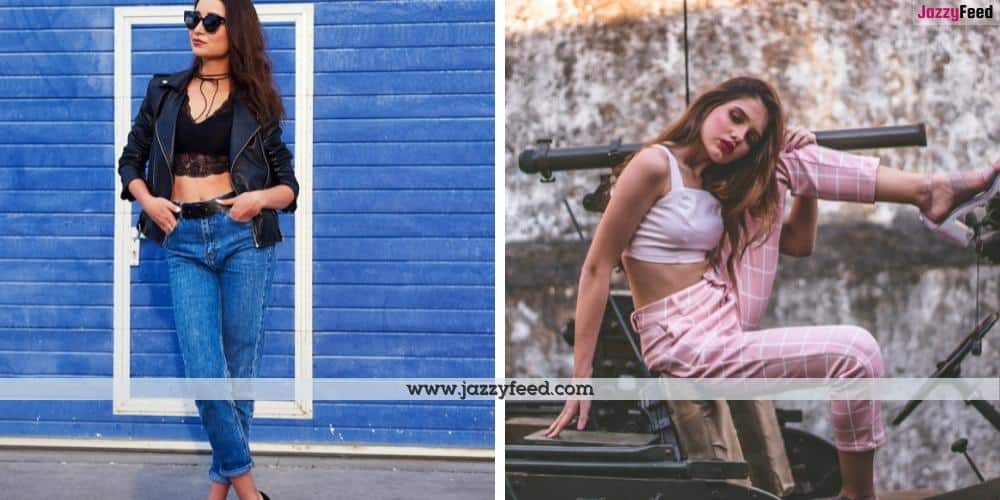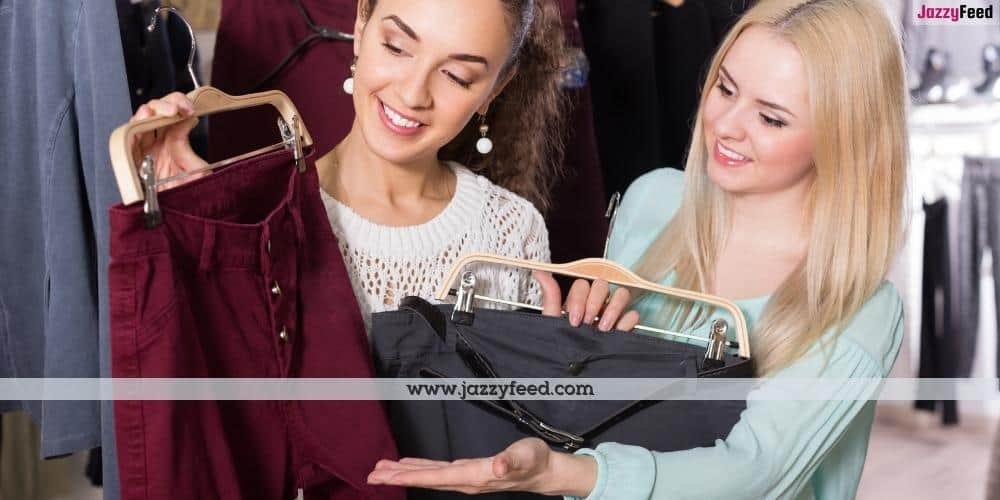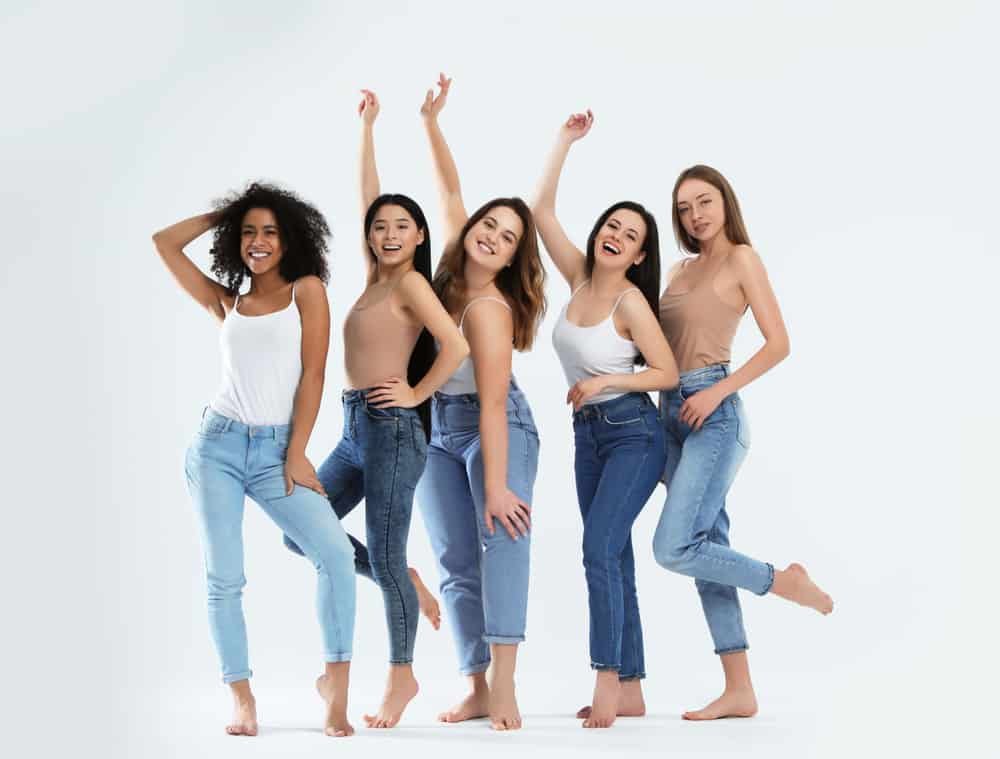It’s hard to imagine a wardrobe without jeans. A wide variety of outfits can be flawlessly worn with them. They’re casual, comfortable, and versatile. In addition, purchasing jeans can be a difficult task. Depending on your unique body shape, you may have difficulty finding jeans that are comfortable and allow you to feel confident.

What to Consider when Shopping for Jeans?
Shopping for jeans can be made easier by several methods. The next time you go shopping, put behind you the discouragement of failed trips and start feeling great in your jeans by following these tips.

1. Don’t Rely on Trends
There are a lot of high-waisted skinny jeans around these days, but that doesn’t necessarily mean they are the jeans that you should purchase. It doesn’t follow that just because a style of jeans is currently trendy that it will flatter your figure.
Fashionable jeans look great on some women, but not on others. It is not wise to buy jeans based on a fleeting fashion trend. Consider what looks good on you instead of what looks good on models in magazines.
2. Remember Jeans Stretch
Denim is a very stretchy fabric, which is why jeans are made of denim. The first time you try on a pair of jeans in the store, they may feel tight and uncomfortable, which can naturally lead you to purchase a bigger size.
The best solution when trying on uncomfortably tight jeans in the fitting room may not always be to size up. The jeans will stretch out once you wear them all day at home, and they’ll likely become unattractive and baggy. Choose jeans that are a little tighter and trust that they’ll stretch to fit you.
3. Find the Right
The key to finding jeans that fit you perfectly and stay that way after you buy them is to find a waistband that won’t be too loose or too tight after you’ve bought them.
The back of the waistband of your jeans should not be able to accommodate your entire hand. The loose waistband may cause you to appear baggy or wider. The back of your waistband should allow you to fit one or two fingers without much difficulty. The waistband may be too tight for you if you can’t adjust it, and it will be uncomfortable and stick to your waist and stomach unattractively.
4. Consider the Crotch
Just like the rest of the denim fabric, your jeans will stretch in the crotch area. The first time you buy a pair of jeans, its crotch area should not be easily grabbable.
After you wear a pair of jeans for a while, the crotch area will stretch to a more comfortable fit. If the fabric in that area does not fit up against your skin and hangs down between your legs instead, you should not buy the jeans.
5. Pick Bootcut or High-Waisted if You’re Curvy
If you have a curvy figure, opt for high-waisted jeans if you want to go for a trendy skinny jeans style. The higher waist of the jeans can help create the illusion of smaller hips and long legs. Bootcut jean styles are also complementary to curvy figures, as they add balance and harmony to your curves.
However, you should never pair bootcut and high-waisted jeans together in one pair of jeans. This style is outdated and can make you look like you’re wearing ‘mom jeans’, which is a look you should always try to avoid whether you have kids or not.
6. Try Extra Flair to Add Shape
The problem that many women have when purchasing jeans is that they feel their body looks flat and shapeless in them. The best way to make a pair of jeans fit better if you don’t have many curves is to buy a pair with extra flair to make your pants look fuller.
Try to find jeans that have extra zippers, buttons, stitching, or designs on the pockets. Although these additions do not improve the fit or function of the jeans, they add interest and texture to them and help you look more shapely.
7. Try Hemming
It is possible to find many pairs of jeans that do not fit you because they are not the right length if you are short or looking for cropped jeans.
Pants that fall too low on your ankles are not a valid reason to not buy them. To tailor jeans to a length that flatters you, you can hem them yourself or get them professionally hemmed.
Do you want to eliminate the hassle and frustration of shopping for a pair of jeans? The tips in this post will help you pick the best jeans for you, so keep them in mind the next time you visit the mall.
Things You Need to Know Before you Go Shopping for Denims?
Denim is the start of a long (and personal) relationship, and just like any other long, intimate relationship, you want the pair you invest in to be the “one.” When faced with hundreds of options accessible online and in stores, making a decision might seem virtually impossible.
What is the best way to choose the right brand, size, silhouette, and wash? These six easy principles will ensure that the pair you purchase is ideal for your body and lifestyle.

1. Define your size
Because many current brands gauge their denim according to waist measurements, it’s best to take your own measures for the best fit. Take a measurement around your natural waist (the smallest region of your waist) with a flexible measuring tape and round down to the whole number. If your waist measures 28.5 inches, you are a size 28.
Once you know your size, the differences between brands are minor. As a result, the rest of the fit preferences will be determined by other parameters such as leg silhouette and rise. Remember that the waistband is the most difficult part of a pair of jeans to adjust, so never skimp on the waistband’s fit.
2. Understand the fit
Because the stretch fibres in most skinny jeans will bag out with wear, skew on the fitting, tight side when choosing sizes. Look for signs about the rise if you don’t like how high or low the jeans sit on your waist.
Because they reach higher on the waist and contour to reveal less overall, a pair labelled “mid-rise,” which is normally at least eight inches, gives more covering. If the rise is too low, don’t try to size up; you’ll just end up with a bad, uncomfortable fit. Instead, seek out a style that is more suited to your body type and level of comfort.
3. Length is negotiable
Adjusting the inseam is a modest change, but jeans should be altered to fit the shoes that will be worn with them. Flares, which look best with heels or wedges, should be about an inch off the ground, while thin jeans should hit just above or at the anklebone.
You may even slash the hem to reveal a raw edge to give dark inky skinny jeans an on-trend appeal.
4. Let the silhouette and wash work for you
Want to hide your hips or give the appearance of longer legs? Dark, whisker-free flares or almost-floor-length trouser trousers are ideal. Play up your legs with lighter washes or extra embellishments like distressed or moto seaming if they’re your finest feature. You don’t want to flaunt your calf muscles? Look for a cigarette leg that falls straight down from the largest portion of your calf and a monochrome wash.
Cast a wide nett and bring a diverse collection to the dressing room, no matter how intimidating it may seem—of styles, washes, and even sizes when it comes to unfamiliar companies. You never know, a pair that doesn’t have a lot of hanger appeal could be incredibly body-flattering.
5. Take a 360-degree approach
Perform a trial run before making a final decision. To check how the jeans look from behind, stand in front of a three-quarter mirror. Then sit on the dressing room bench and do a few of squats to make sure you’re not uncomfortable, the denim doesn’t stretch out, and you’re not showing too much skin.
6. Stick with what works
“Keep things basic,” Peggi Jewell, Vice President of Merchandising and Design at 7 For All Mankind, advises. Determine what fit is most comfortable for your physique and makes you feel confident, and then stick to it.
It’s like understanding which hairstyle complements your face shape the best.” When you’ve found a brand or style that you like, use it as a starting point and experiment with washes and tiny silhouette changes. Last but not least, be patient. It’s a worthwhile procedure in the end.
How Do You Choose the Best Quality Jeans?
When it comes to jeans, quality is everything. Deluxe denim will not only feel better, but it will also endure longer. While designer labels are more likely to spend in high-end materials and fabrics, it doesn’t rule out the possibility of finding well-made jeans at a lower cost. The key is to distinguish between the nice material and the crap that will tear at the seams (literally).
So, what constitutes a pair of jeans high-quality? And how do you know whether you’ve discovered the right match? To assist you, we’ve put up the ideal jeans shopping checklist that you can use the next time you’re in the market for some new denim.

A Heavier Fabric
It’s all about the sense of touch. Denim that is stronger and heavier is used to make high-quality jeans. They should not only appear but also feel luxury. So, when you’re out shopping, get your hands on the cloth. Aside from summer jeans, lightweight denim (i.e. anything under 12-ounces) is generally considered to be of poorer quality. If you can’t find the denim weight on the label, ask a salesman. Check to see if the fabric weight (“low,” “medium,” or “heavy”) is indicated in the comprehensive product description if you’re shopping online.
NOTE: Heavier denim jeans may seem stiff at first, but after a few wears, they will soften. If patience is not one of your virtues, you may speed up the break-in process by soaking your jeans in a vinegar-and-hot-water bath.
Durable Stitching
The quality of a pair of jeans can be determined by the stitching around the hems, pockets, and side seams. You want a strong stitch that won’t pull, split, or unravel under pressure. Double-stitching (two rows of close-together stitches) and chain-stitching (a looped stitch that resembles the links of a chain) are both evidence that the jeans were made with additional care. Still, a single row of stitches will suffice as long as the thread is thick and robust.
Give a pair of jeans the old durability test to see if they’re up to the task: Stretch it gently at the seams. If you notice or hear threads pulling apart, you know what that means, my friends: bad workmanship. If you’re purchasing online, you can use the zoom tool (if it’s available) to study stitching details.
The Stretch Factor
If you prefer form-fitting comfort in your jeans, stretch denim is the way to go. When looking for stretch jeans, look for the proportion of Lycra or Spandex in the fabric on the label. You’re aiming for a maximum of 2%. Even though stretch jeans are constructed of fabric that is designed to stretch and give, they should only stretch so far (unless they’re jeggings).
As a general rule, 1% will give you only a hint of stretch for comfort, whilst 2% will give you a more generous cloth. You might expect the jeans to wear out or get saggy if you wear them any longer. And, because stretch jeans are designed to fit snugly, if you’re in between sizes, go down a size because the fabric may loosen with repeated wears.
Design Details
Certain design elements and materials on a pair of jeans can sometimes help you determine if they’re built to last. Take, for example, copper buttons and rivets. When you see these little fellas on a pair of pants, you know the brand has put effort into crafting a well-made product.
A word of caution, though: don’t be deceived by the impostors. Some knock-off brands have mastered the art of imitating the look of premium jeans. The top denim brands and their knockoffs can both have curved back pockets, for example, so it’s always advisable to inspect the fabric of a garment rather than relying just on design aspects.
Proceed with caution if you can’t discover this information on the jeans’ label or website. When a company employs high-quality materials in their pants, it usually advertises it.
Price Isn’t Everything (But It’s a Good Sign)
Designer jeans aren’t cheap, despite our best efforts and prayers to the retail gods. Sure, they’re the pinnacle of denim, but does that really justify eating Cup O’Noodles for the next month just to get your hands on a pair? Allow designer denim to serve as a quality compass as an alternative.
Allow yourself to enjoy trying on a few pairs of designer jeans. Even if you don’t plan on purchasing them, they’ll give you a sense of how higher-quality denim feels. Not going to lie, this might be risky because, after all, who wants to walk away from a pair of perfectly fitting jeans? However, if you have the discipline, you may use what you learned in the fitting room to shopping for quality mid-range labels. Two of our all-time favourites are the iconic Levi’s and the eco-conscious Everlane.

